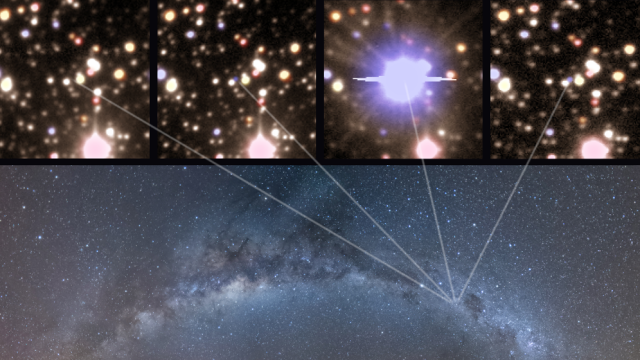In 2009, a binary star that had been flaring up for years suddenly exploded, growing millions of times brighter in a cosmic blink. Now, after carefully studying the lead up to and aftermath of the extraordinary event, a team of Polish astronomers describes what happened in a new scientific paper. Basically, a zombie star charged up and went thermonuclear — and it could happen again.
Image: J. Skowron, K. Ulaczyk / Warsaw University Observatory
The star system in question — V1213 Cen, located 23,000 light years away in the Scutum-Centaurus arm of the Milky Way — consists of two close-knit companions, a dim red dwarf and a dead stellar core known as a white dwarf. It’s a parasitic relationship in which the dead star slowly feeds off its living counterpart, siphoning matter away and occasionally flaring up in stellar outbursts known as dwarf novae.
Eventually in this sort of binary system, the dead star will accrete enough fresh hydrogen and helium to build extraordinary pressures and temperatures, sparking a runaway thermonuclear fusion reaction. Tremendous amounts of matter and energy are then released, lighting up the sky in a brief but brilliant classical nova. This is exactly what our telescopes observed happening to V1213 Cen in 2009.
Astronomers have known about classical novae for centuries, but owing to the transient nature of these outbursts, they have proven rather difficult to study. V1213 Cen was different. Thanks to the University of Warsaw’s Optical Gravitational Lensing Experiment — a long-term dark matter survey that stares at a billion-odd stars in the galactic bulge — astronomer Przemek Mroz was able to collect continuous data on V1213 Cen for six years prior to and after the 2009 nova, creating one of the most complete records to date.

Snapshots of V1213 Cen’s novae life cycle (top), and the position of the star in the sky as seen from the Warsaw telescope dome (bottom). Image: J. Skowron, K. Ulaczyk / Warsaw University Observatory
His findings, published today in Nature, offer important insights into how classical novae evolve over time; supporting a previously untested model known as the “hibernation hypothesis”.
According to this hypothesis, after a classical nova erupts, the rate of mass transfer between the two stars is elevated for centuries. The system remains brighter than it was before the explosion. Then, over the course of thousands to millions of years, the feeding frenzy simmers down as the white dwarf enters a “hibernation phase”. Eventually, the dead star will awaken to gobble its companion once more, starting the cycle over.
“This is something every researcher in the field of binary stars thought might happen, but the probability of observing it was considered very low,” Mroz told Gizmodo. “We believe our data supports it.”
Mroz added that V1213 Cen is slowly fading now in accordance with hibernation theory. By continuing to study the dynamics of the system in the years ahead, Mroz hopes to solve more mysteries about how binary systems evolve and self-destruct over cosmic time.
Personally, I’m just relieved we found a reasonable scientific explanation for Starkiller Base.
